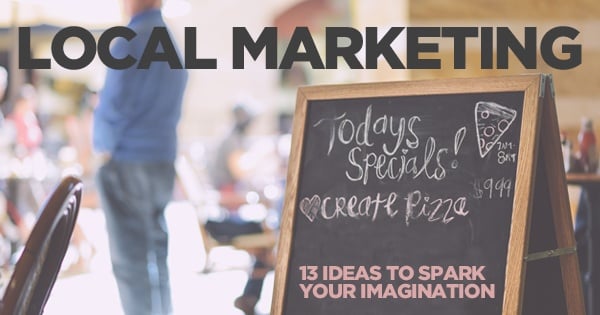
With the recent rise of Pokémon GO, small and local businesses are looking to capitalize on all the extra foot traffic, so now is a great time to evaluate your local marketing strategy.
Local marketing refers to a strategy that specifically targets marketing efforts to potential consumers and customers in the nearby area. Local marketing can take a variety of forms, from traditional marketing methods to digital.
Before we get to the list of local marketing ideas, first there are a few items that your company needs to have before focusing on local marketing. The first is an easy-to-use, mobile-responsive website. It is becoming increasingly popular for mobile users to search for restaurants, shops, and services near them in real time. To take advantage of these ready-to-buy consumers, your website has to look its best on any platform. A mobile-responsive site allows for one site to look consistent across many different screen sizes and enables a local user to find information quickly.
The second item needed before implementing a local marketing campaign is the knowledge of your ideal buyer, also known as a buyer persona. A buyer persona is a fictionalized version of your target audience. To create a buyer persona, ask yourself questions about where your ideal buyer would find their information, what sort of pain points they would have that your product or service could fix. Once you have two or three buyer personas to target, you can use these imagined people as the audience when coming up with a local marketing strategy.
Another necessity is an identifiable logo. A brand identity shouldn’t be overlooked when considering marketing strategies. A logo is the way consumers and customers will be able to identify your company versus any other. It should embody your company’s values and it should bring to mind past good experiences whenever a consumer sees it. The company logo should be on all pieces of marketing materials, to create an even stronger connection between your company and your audience. Many of the ideas on the list below can start as template, which can be copied and edited anytime a new one is needed.
Now that the basics are covered, you can move on to starting your local campaign. For some inspiration on how to strengthen your small business’ local marketing strategy, see our list below.
Traditional Local Marketing
Billboards
A billboard or other outdoor advertising can target large areas and be used in general marketing strategies. But by buying billboard space near your location, you can capitalize on people who are currently in the area and might stop by. Consider a bus stop ad or a Big Belly—these ads cater to people who are walking or taking public transportation and who are more likely to walk the extra block to get to your location. Billboards advertising to passing cars are good for brand awareness but might not have the same impact from foot traffic as ads in the line of sight of patrons from the neighborhood.
Outdoor sandwich board
A chalkboard easel set up outside of a shop may be commonplace, but it is still in consistent use for a reason. Done well, a sandwich board can alert passersby about special daily deals or showcase the company’s voice by displaying a timely quote or sarcastic quip. A bookstore I frequent is located in a shop down an alley, and their board simply has their logo and an arrow guiding people to their shop. The board disrupts a walker’s view of the sidewalk and should engage them and entice them to stop.
Window signs
Another way to stop people in their tracks is by use of window displays or signs to advertise deals or specific products. Retail stores frequently use these as a method of advertisement, and service businesses and showrooms can also take advantage of opportunities windows allow. Restaurants typically want to keep their windows clear for customers to look out and hungry passersby to look in, which is an advertisement in and of itself.
Placards and fliers
Having smaller signs either displayed sparingly throughout your business or hung on local community boards can also spread the word about your company or timely events. An 8.5×11 flier can convey an upcoming event or discount in a concise way, while also allowing your audience to take one as a reminder or to share with friends.
Brochures or menus
Similar to fliers, a brochure for storefronts or service businesses can help stay top-of-mind for those who aren’t ready to shop but are interested in your offerings. Having an outdoor holder—similar to real estate fliers outside a house for sale—or a designated spot at the customer service desk can provide a way for potential customers to pocket a brochure to remind them of your services when they are needed or of your menu when looking for a new restaurant to try.
Business cards
This classic way of exchanging information is still useful. Generic business cards left at the cashier, customer service desk, or other prominent place in your store is an easy way to allow visitors to take home a reminder of the things they found. Adding one to a customer’s bag after purchase is also advisable. Business cards can be exchanged at local networking events or handed out while meeting potential partners in unexpected places. Make sure the logo is clear and visible, along with the most updated contact information.
Local newspapers
One way to advertise special events or product launches would be to connect with a local newspaper. If you’re intimidated by big names like the Chicago Tribune or Sun-Times (which you shouldn’t be), there are neighborhood or suburban papers that cater to a much more localized audience. For events in particular, get in touch with local free papers like The Reader or RedEye to advertise both in print and online. Know where your buyer persona searches for upcoming events and plan accordingly.
Chamber of Commerce
Joining the local chamber of commerce can boost your visibility in ways other channels can’t. Having a good relationship with the people working at the chamber can mean that they recommend you and your business to people who are new to the neighborhood or that they come to you when they need sponsors for an upcoming event. Joining a chamber will also allow you to be included on their online directory, which can enhance your website’s search engine optimization as well as your credibility to those who are searching for you online.
{{cta(’58f79806-dd4b-46f0-abdd-f0059d287704′)}}
Digital Local Marketing
Google Local
With Google being the most used search engine, you want your business to show up first in search. While your website’s SEO can help accomplish this, claiming your business’ Google Local page can also place you on the map—literally. When you verify your company’s Google Local page, you have control over the information that gets distributed via Google in terms of hours, location, and website link. You can also add pictures or a virtual tour to increase interest. Google Local connects to Google Search and Google Maps, so no matter how someone searches for your company, they’ll be able to find you.
Other search engines
Just like Google, Bing and Yahoo also have their own local directories. Claim these pages and make sure the information is updated, so if a possible customer searches on a lesser-known search engine, they’ll still be able to find what they’re looking for: you.
Review sites
Review sites like Yelp and Angie’s List also allow businesses to claim accounts. Again, keeping information up-to-date is crucial, as well as linking back to your website. Yelp is usually the first place a user goes to look at reviews of local eateries, then heads to the website to get a better sense of the restaurant. Angie’s List is a site catering to service providers, so making sure that your website and phone number are up to date must be done.
Google AdWords
Like billboards, Google AdWords can be used to display ads across a broad number of searches. Taking the time to add some location targeting or adding keywords like “Chicago” or “Evanston” can boost engagement for people in that area, while possibly saving your marketing budget. You only pay for clicks and if those clicks are more likely to lead to purchases because of the increased targeting, your return on investment can skyrocket.
Facebook ads
In the same way, Facebook ads allow businesses to get very specific with the audience they want to target. Boost a popular post to get in front of a relevant audience or create an ad from scratch that targets a certain age group. The amount of data Facebook knows about its users can come in handy when you want to target a specific audience.
To learn how you can take advantage of these local marketing strategies and more, talk to us today.
{{cta(‘c065f20d-94ff-473e-b9df-d785aee6e01f’)}}
